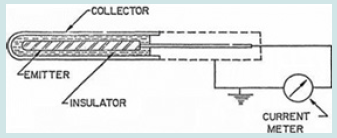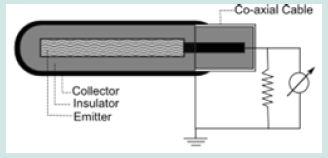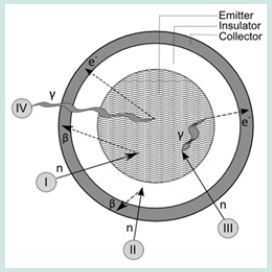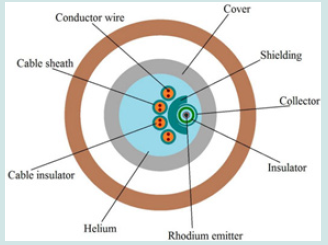
Lupine Publishers Group
Lupine Publishers
Menu
ISSN: 2641-6921
Mini Review(ISSN: 2641-6921) 
Self-Powered Neutron Detectors (SPNDs) Driven Incore Nuclear Reactor Instrumentation Volume 5 - Issue 2
Bahman Zohuri1*, Seyed Kamal Mousavi Balgehshiri2 and Ali Zamani Paydar2
- 1Galaxy Advanced Engineering, Chief Executive Officer, United States of America
- 2Physics and Energy Engineering Department, Amirkabir University of Technology, Tehran, Iran
Received:June 19, 2023; Published: June 21, 2023
*Corresponding author:Bahman Zohuri, Chief Executive Officer, Galaxy Advanced Engineering, Albuquerque, New Mexico, 87111, United States of America
DOI: 10.32474/MAMS.2023.05.000209
Abstract
Self-Powered Neutron Detectors (SPNDs) are specialized devices used for detecting and measuring neutron radiation. Unlike traditional detectors that require external power sources, SPNDs are unique in that they generate their own electrical power from the radiation they detect. Self-Powered Neutron Detectors (SPNDs) find important applications in the core of Light Water Reactors (LWRs), which are the most common type of nuclear power reactors. Here are some key applications of SPNDs in LWR cores. In summary, Self-Powered Neutron Detectors (SPNDs) are neutron detectors that generate their own electrical power from the radiation they detect. They are used for measuring neutron flux and dose rates in various applications. While they offer advantages such as self-sustained power and wide dynamic range, they are also sensitive to gamma radiation and may experience degradation over time.
Keywords: Reactor control system; incore power detector instrumentation; neutron flux measurement incore; light water reactor; boiling water reactor and pressurized water reactor
Introduction
Self-Powered Neutron Detectors (SPNDs) are specialized devices used for detecting and measuring neutron radiation. Unlike traditional detectors that require external power sources, SPNDs are unique in that they generate their own electrical power from the radiation they detect. SPNDs typically consist of a thin metallic film, such as platinum or boron, that is placed in close proximity to a neutron source. When neutrons interact with the film, they induce fission reactions or capture reactions, which release charged particles. These charged particles create an electric potential difference across the film, generating an electrical current that can be measured. The current generated by the SPND is proportional to the intensity of the neutron radiation. By calibrating the device, the current output can be correlated to the neutron flux or dose rate. SPNDs are often used in nuclear power plants, research facilities, and other environments where accurate neutron measurements are crucial for safety and operational purposes.
The advantages of SPNDs include their self-sustained power supply, which eliminates the need for external power sources or batteries. This makes them reliable and suitable for long-term monitoring. Additionally, SPNDs have a wide dynamic range, allowing them to measure both low and high neutron fluxes accurately. They also have fast response times and can provide real-time information about neutron radiation levels. However, SPNDs also have some limitations. They are sensitive to gamma radiation and may produce a response to gamma rays that can interfere with the accuracy of neutron measurements. Additionally, the thin film in SPNDs can degrade over time due to radiation damage, reducing the device's sensitivity and lifespan. Moreover, Self-Powered Neutron Detectors (SPNDs) are neutron detectors that produce their own electrical energy from the radiation they detect. They are employed in numerous applications to gauge neutron flux and dosage rates. They have benefits including self-sustaining power and a large dynamic range, but they are also gamma radiation sensitive and may deteriorate over time.
Self-Powered Neutron Detectors (SPNDs) have been successfully employed as in-core flux monitors in nuclear power reactors all over the world for more than 25 years. Although not used in BWRs, SPNDs have been employed in PWRs, Heavy Water, and Graphite Moderated Light Water reactors. They have mostly been employed for flux mapping and control tasks. Core protection tasks have also been performed using prompt SPNDs. The SPND has a ceramic insulator surrounding a neutron-sensitive metallic emitter. The cylindrical assembly is enclosed in a metallic sheath. The atomic nuclei of emitters interact with neutrons in SPNDs to produce a signal that is inversely proportional to the neutron flux. When electrons are released after neutron capture, an SPND detector is able to produce an electrical current. Since the emitter material turns radioactive and emits beta particles when hit with a neutron flux, it does not require an external power source. Figure 1 depicts a typical SPND. Its three basic components are an insulator, a collector sheath, and an emitter and each of these components are described holistically here. As illustrated, also in Figure 2, the typical SPND is a coaxial cable consisting of:
a. Emitter : An inner electrode is made from a material that absorbs a neutron and undergoes radioactive decay by emitting an electron (beta decay). The emitter is usually made of Rhodium (Rd) and is used to produce electrons.
b. Insulation : The emitter is surrounded by insulation, usually made of aluminum oxide.
c. Collector : The metal walls of the detector encase these parts and serve as a collector. electrons that are produced. The collector is attached to ground potential.
Furthermore, the three main types of interactions occurring in a self-powered neutron detector are n/beta, n/gamma/electron, and gamma/electron and Figure 3 is illustration and examples of possible interactions in an SPND that contribute to the detector current and are (I) and (II) as (n, β-), (III) (n, γ), (γ, e−) and (IV) (γ, e−).
As part of description “Instantaneous Response” of SPND, An SPND can provide a signal as a result of the electrons created by both external gamma radiation from the activated nearby materials and internal gamma radiation emitted after the capture of neutrons in the detector. This interaction is shown in Figure 3 as sequences (III) and (IV), respectively. The SPND has immediately responded in this manner. Electrons are produced by the gamma rays' interactions with the detector material, most commonly through Compton scattering, but also through photoelectric effect and pair creation. A current is created in the external circuit when electrons enter the collector. The likelihood that the electrons will halt in the insulator or emitter material is small. After several collisions, the electrons in the emitter cease, but no signal is produced. Others that land in the insulator produce a buildup of negative charge and an electric field in the area. In order to create a current in the external circuit, the field forces electrons out of the insulator and either to the emitter or the collector.
In respect to “Delayed Response”, a radioactive nucleus that beta decays into another state is created in the emitter as a result of a neutron capture (n, gamma process). If the betas being released have enough energy, they can make it to the collector. Several secondary interactions are experienced by these recoil electrons before they start to contribute to the current. Sequences (I) and (II), two examples of these interactions, are shown in Figure 3. Here, too, the charge transfer procedure is applicable. An electric field is produced as a result of the beta transfer from the emitter to the insulator, which causes a buildup of negative charge. Depending on whether the betas are pushed towards the collector or returned to the emitter, the resulting field affects the net current measured by the collector. The half-life of the beta-emitting nucleus, which might be anywhere between a few seconds and several minutes, dictates how quickly the detector responds. Betas create charge transfers with response periods of several minutes in Rhodium and Vanadium (V) SPNDs types, which are typical instances.
Note that: An SPND with a Vanadium (51V) emitter has relatively low sensitivity, low burn-up rate, minimal perturbation of the local power density, and a very long delayed signal. A vanadium-based detector is the beta-current type of self-powered detector, which uses the following activation reaction to produce a current that can be measured.
Vanadium-51 (51V) has a capture cross-section of 4.9 barns for thermal neutrons without resonances. This reaction leads to the production of 52V with T1/2 = 3.74 min, which is beta radioactive.
The following characteristics are typical when used in thermal power reactors (e.g., PWR).
a. The vanadium burnup rate is 0.012% per month in a thermal neutron flux of 1013n/cm2/sec.
b. 99% of the signal has a half-life of 3.8 minutes.
c. 1% of the signal is prompt.
d. The subsequent beta emission has an energy of 2.6 MeV.
However, the gamma sensitivity of a vanadium Self-Powered Neutron Detector (SPND), type 9 VNI 37/300/2, manufactured by Thermocoax, France, has been measured at 60Co photon energy and is found to be 1.56 x 1016 A rad/h. All SPNDs exhibit both prompt and delayed responses to some extent, but depending on which is more important and how quickly they respond, they are classified as either prompt or delayed response detectors. Depending on whose contribution to the signal (delayed or instantaneous) is dominant, the SPND is classified as either a delayed or prompt-response detector. A two-step, each with a small probability, method is used to generate the prompt signal. As a result, a prompt-response SPND has a lesser sensitivity than a delayed-response SPND. The detector can track changes in the reactor's power profile since the response is immediate and the current is proportional to the prompt neutron flux.
These current signals, which are primarily generated by the n/beta interactions within the emitter, are created by delayed response detectors. In other words, detector signals are inversely proportional to the neutron absorption interaction rate (nvt) rather than the neutron flux (nv). Due to their minimal contributions to the final signal, the isomers produced by neutron interaction in the SPND are also frequently overlooked in detector studies. The response of the SPND must be examined by a computer-driven algorithm to obtain a value proportionate to neutron flux in order to achieve the highest accuracy and run-time performance. Dynamic correction of SPND response is what this is known as. The RAST-K v 2.0 code, used in South Korean Nuclear Industry, is an example of these computer codes. including PARCS and SIMULATE 3 obtainable of IAEA.
Application of SPND Incore of Light Water Reactors Types
Self-Powered Neutron Detectors (SPNDs) find important applications in the core of light water reactors (LWRs), which are the most common type of nuclear power reactors. Here are some key applications of SPNDs in LWR cores: [1]
1. Reactor Power Monitoring : SPNDs are used to monitor the power output of the reactor core. By measuring the neutron flux, which is directly related to the power level, SPNDs provide continuous and real-time information about the reactor's power generation. This data is vital for maintaining safe and efficient operation of the reactor.
2. Reactor Control : SPNDs play a crucial role in reactor control systems. They provide feedback to the control rods, which are used to adjust the reactivity (neutron population) in the core. By accurately measuring the neutron flux, SPNDs help maintain the desired power level and ensure stable and controlled reactor operation.
3. Safety Monitoring : SPNDs are important for safety monitoring in LWR cores. They provide information about the neutron flux distribution within the core, helping to identify any abnormal or off-normal conditions. Deviations in neutron flux patterns can indicate potential fuel assembly or core cooling issues, allowing operators to take appropriate corrective actions to maintain the safety of the reactor.
4. Fuel Performance Monitoring : SPNDs are used to assess the performance of fuel assemblies in the reactor core. By measuring the neutron flux in different locations, SPNDs provide valuable data on the burnup (depletion of fissile material) and power distribution within the fuel assemblies. This information is essential for evaluating fuel performance and optimizing fuel management strategies.
5. Reactor Diagnostics and Analysis : SPND data is extensively used for reactor diagnostics and analysis. By analyzing the neutron flux measurements from SPNDs, engineers and scientists can study core behavior, assess fuel depletion rates, investigate spatial power distributions, and validate computational models used for reactor simulations. This information aids in enhancing the safety, efficiency, and overall performance of LWRs.
In summary, SPNDs play vital roles in monitoring and controlling the operation of light water reactors. They provide essential data for power monitoring, reactor control, safety monitoring, fuel performance assessment, and reactor diagnostics. These applications contribute to safe and efficient operation of LWRs, ensuring reliable and sustainable nuclear power generation.
Fact Finding about Self-Powered Neutron Detectors
A Self-Powered Neutron Detector (SPND) is a type of radiation detector specifically designed to measure neutron radiation. Here are some key facts about SPNDs:
1. Principle of Operation : SPNDs operate based on the principle of neutron capture. When a neutron interacts with the detector material, it undergoes a capture reaction, resulting in the emission of charged particles. These charged particles create an electric field that generates a measurable current, providing a means to detect neutron radiation.
2. Self-Powered Operation : SPNDs are self-powered, meaning they do not require an external power supply or batteries to operate. The detection mechanism relies on the energy generated by the neutron capture reaction within the detector material. This feature makes SPNDs suitable for long-term monitoring applications where power availability might be limited or impractical.
3. Detector Material : The most commonly used material in SPNDs is typically a compound containing boron-10 (10B), which has a high probability of neutron capture. Boron-10 captures thermal neutrons and emits an alpha particle and a lithium-7 (7Li) nucleus, generating the electric current that is measured.
4. Sensitivity and Response : SPNDs are designed to have a high sensitivity to neutron radiation. The detector response is proportional to the neutron flux, allowing for accurate measurements of neutron intensity. The response time of SPNDs can vary depending on the design and configuration but is typically in the order of milliseconds to seconds.
5. Application Areas : SPNDs find applications in various fields where neutron radiation monitoring is essential. Some common areas of use include nuclear power plants, research reactors, neutron sources, and radiation therapy facilities. They are also employed in scientific research, industrial applications, and nuclear safeguards.
6. Calibration and Maintenance : Like other radiation detectors, SPNDs require periodic calibration and maintenance to ensure accurate and reliable measurements. Calibration involves exposing the detector to a known neutron source or using standard calibration facilities. Regular maintenance includes checking for any physical damage, cleaning the detector surface, and verifying its electrical connections.
7. Limitations : While SPNDs offer several advantages, they also have some limitations. One limitation is their inability to discriminate between different neutron energies. Additionally, the detector response can be influenced by factors such as temperature and humidity, which may require compensation or correction during data analysis.
Furthermore, it is notable that:
a. Self-powered neutron detectors are usually placed into the instrumentation tube of a fuel assembly.=
b. They can monitor the entire length of selected fuel assemblies to provide an accurate, three-dimensional map of the neutron flux distribution.
c. Neutron flux reconstruction can also be performed in the rest of the reactor core using these collected data.
d. Typical materials used for the emitter are, Cadmium, Rhodium (Figure 4), Cobalt (Figure 5) and Vanadium. These materials should be used because they possess relatively high melting temperatures and high cross sections to thermal neutrons and are compatible with the SPND manufacturing process.
e. Self-Powered Neutron Detectors have been used effectively as in-core flux monitors for over twenty-five years in nuclear power reactors world-wide.
The calibration of self-powered neutron detectors may be performed at the installation site (in-situ), or in a test reactor prior to final installation.
Note that : Both Figures 4 & 5 are representing, Self-Powered Neutron Detector (SPND) Rhodium and Cobalt Type Configurations [2].
It is important to note that specific details about SPNDs, such as the design, sensitivity, and operational characteristics, can vary depending on the manufacturer and intended application.
Typically, engineers and scientists involved with calculation of the transition functions of Self-Powered Neutron Detectors (SPNDs) are considering two options of geometry description as: [3]
1) Homogeneous, and
2) Heterogeneous.
In the homogeneous instance, the detector is depicted as a rhodium wire encircled by a layer of homogenized detector parts that is cylindrical in shape. A thorough description of SPND components is used in the heterogeneous instance. Figure 6 depicts an example with heterogeneity. The Gamma Thermometer (GT) and the Self-Powered Neutron Detector (SPND) are both types of radiation detectors, but they differ in their specific applications and principles of operation. Here's a comparison between the two:
Gamma Thermometer (GT)
1. Principle of Operation : The GT is primarily designed to measure gamma radiation. It operates based on the principle of ionization, where gamma photons interact with the detector material, causing ionization of the atoms within. This ionization generates an electric current that is proportional to the gamma radiation intensity.
2. Gamma Sensitivity : GTs are specifically optimized for detecting and measuring gamma radiation. They are highly sensitive to gamma rays across a wide range of energies, allowing for accurate measurements in various environments.
3. Power Requirements : GTs typically require an external power source, such as batteries or an electrical connection, to operate. The power is needed to supply the electric current for ionization detection and to enable the necessary electronic circuitry for signal processing and data output.
4. Application Areas : GTs are commonly used in areas where gamma radiation monitoring is crucial, such as nuclear power plants, industrial facilities working with radioactive materials, and radiation therapy centers. They are also employed in environmental monitoring, radiography, and homeland security applications.
Self-Powered Neutron Detector (SPND)
1. Principle of Operation : SPNDs are primarily designed to measure neutron radiation. They operate based on the principle of neutron capture, where neutron particles interact with the detector material and undergo a capture reaction. This reaction generates charged particles that create an electric field, resulting in a measurable current.
2. Neutron Sensitivity : SPNDs are specifically optimized for detecting and measuring neutron radiation. They are highly sensitive to neutrons, particularly thermal neutrons, and are used to determine neutron flux and intensity in various environments.
3. Self-Powered Operation : SPNDs do not require an external power source to operate. They rely on the energy generated by the neutron capture reaction within the detector material to produce the electric current for detection. This self-powered feature makes them suitable for long-term monitoring applications where a continuous power supply may not be available or practical.
4. Application Areas : SPNDs are commonly used in nuclear power plants, research reactors, neutron sources, and other facilities where neutron radiation monitoring is essential. They are also employed in scientific research, industrial applications, nuclear safeguards, and other fields that require precise neutron measurements.
In summary, the key differences between GTs and SPNDs lie in their primary radiation detection focus, with GTs optimized for gamma radiation measurement and SPNDs specialized for neutron radiation detection. Additionally, GTs typically require an external power source, while SPNDs are self-powered. The specific choice of detector depends on the type of radiation to be measured and the intended application.
Furthermore, Gamma Thermometers (GTs) are specialized detectors for measuring gamma radiation levels, while Self-Powered Neutron Detectors (SPNDs) are designed for neutron detection. Gamma thermometers are highly sensitive to gamma radiation and require an external power source, while self-powered neutron detectors are less sensitive to neutrons but operate independently. The choice between the two depends on the specific radiation monitoring needs and the types of radiation present in the environment.
Conclusion
In-core detectors with fixed or movable detectors as well as fixed in-core detectors with no or low burn-up factors, such as vanadium self-powered detectors or gamma thermometers, single or multiple movable in-core fission chambers, or self-powered detectors located in calibration tubes within each self-powered detector assembly, are all well-known and well-tested. By contrasting an SPND with a typical SPND, one can establish the absolute neutron sensitivity of the latter. The fundamental procedure entails exposing the SPND that is undergoing calibration (the test SPND) and a standard SPND (a detector with known absolute neutron sensitivity and physical characteristics identical to those of the test SPND) to a neutron source, typically a thermal source, and measuring the output currents that result. Sensitivity is easily determined by multiplying the absolute neutron sensitivity of the standard SPND by the test SPND's measured output divided by the standard SPND's measured output current. (Corrections may need to be made to account for flux differences between the calibration location of the test SPND and the standard SPND).
References
- Ali Zamani Paydar, Seyed Kamal Mousavi Balgehshiri, Bahman Zohuri (2023) Advanced Reactor Concepts (ARC): A New Nuclear Power Plant Perspective Producing Energy 1st Edition, Elsevier Publishing Company.
- William H, Todt SR (1998) Characteristics of Self-Powered Neutron Detectors. Imaging and Sensing Technology Corporation, Horseheads, New York, USA.
- Bikeev AS, Kurchenkov AYU, Shkarovsky DA, Shkityr VV (2019) Calculation of The Transition Functions of Self-Powered Detectors For Vver-1000 By Means of The Mcu-Pd And Tvs-M Codes.

Top Editors
-

Mark E Smith
Bio chemistry
University of Texas Medical Branch, USA -

Lawrence A Presley
Department of Criminal Justice
Liberty University, USA -

Thomas W Miller
Department of Psychiatry
University of Kentucky, USA -

Gjumrakch Aliev
Department of Medicine
Gally International Biomedical Research & Consulting LLC, USA -

Christopher Bryant
Department of Urbanisation and Agricultural
Montreal university, USA -

Robert William Frare
Oral & Maxillofacial Pathology
New York University, USA -

Rudolph Modesto Navari
Gastroenterology and Hepatology
University of Alabama, UK -

Andrew Hague
Department of Medicine
Universities of Bradford, UK -

George Gregory Buttigieg
Maltese College of Obstetrics and Gynaecology, Europe -

Chen-Hsiung Yeh
Oncology
Circulogene Theranostics, England -
.png)
Emilio Bucio-Carrillo
Radiation Chemistry
National University of Mexico, USA -
.jpg)
Casey J Grenier
Analytical Chemistry
Wentworth Institute of Technology, USA -
Hany Atalah
Minimally Invasive Surgery
Mercer University school of Medicine, USA -

Abu-Hussein Muhamad
Pediatric Dentistry
University of Athens , Greece

The annual scholar awards from Lupine Publishers honor a selected number Read More...










